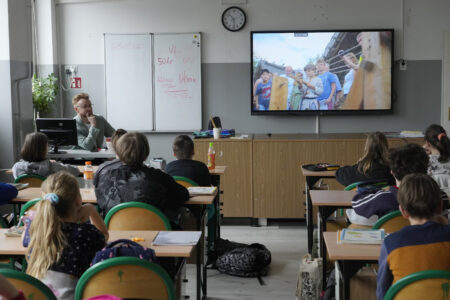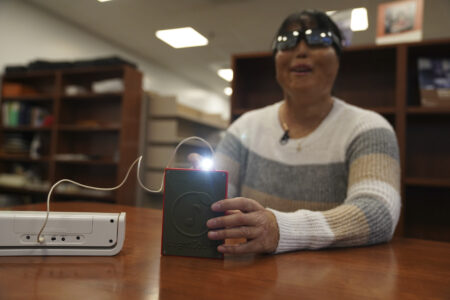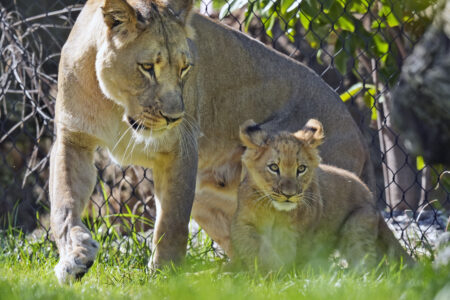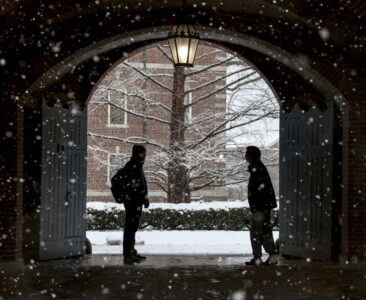Opening the ‘Aperture’
Panel discusses DeVos exhibit

A discussion takes place Friday about the DeVos Art Museum's exhibit, "Aperture." From left are Emily Lanctot, DeVos curator of collections and outreach; Lali Khalid, photographer and co-founder of The Creative House; Leslie Larkin, Northern Michigan University associate professor of English; Tracy Wascom, NMU assistant professor of art and design; and Patricia Killelea, NMU assistant professor of English. (Journal photo by Christie Bleck)
MARQUETTE — A photograph can draw in a viewer’s gaze for reasons as varied as the viewers themselves.
Pictures ranging from compelling portraits to more abstract images were discussed in a panel forum Friday at the DeVos Art Museum at Northern Michigan University.
The discussion coincided with the “Aperture” exhibit that runs through April 1 at the museum.
Leading the talk was Emily Lanctot, DeVos curator of collections and outreach, with panelists including Patricia Killelea, NMU assistant professor of English; Lali Khalid, photographer and co-founder of The Creative House; Leslie Larkin, NMU associate professor of English; and Tracy Wascom, NMU assistant professor of art and design.
“They’re looking at several images through the context of their own research,” Lanctot said of the panelists.
The Aperture Foundation, based in New York City, was formed in 1952 by photographers and writers as a common ground for the advancement of photography, according to aperture.org. Aperture today is a multi-platform publisher and center for the photo community.
The DeVos exhibit follows the evolution of the foundation through a display of photographs from its print and fundraising programs created over a 50-year time period.
“The history of Aperture is embedded in our mission, which is to connect both the photo community and its audiences with the most inspiring work, the sharpest ideas, and with each other in print, in person and online,” Lanctot said.
Although she’s not a photographer — her work, she joked, consists of blurry Instagram pictures of snowstorms and selfies — Killelea shared her ideas about the Aperture exhibit.
“I’m coming to this as a writer and also as an experimental filmmaker,” Killelea said.
She looked at the exhibit for story images and their language, and as a series of motions as opposed to something static.
One of the photographs she addressed was Paul Strand’s 1933 photograph, “Gateway, Hidalgo,” taken in Mexico.
It’s a haunting black and white architectural image.
As with many “Aperture” photographs, though, there’s more to it than meets the eye.
Killelea pointed out the photo is specific to a place and time as well as a community of people.
“One thing I’m paying attention to here is ‘relationality’ — how things relate to each other — and I’m wondering what this image can teach us about relationships and how we can also maybe politicize this image in a way that doesn’t place humans at the center, even though human-made structures figure heavily in the photo,” Killelea said.
Khalid talked about documentary photographers who focus on art, not only providing information about what they photographing but challenging the public to become socially involved.
One of those photographers, whose work is in “Aperture,” was LaToya Ruby Frazier, who Khalid said places herself “inside” her photos, not as an outsider.
Khalid said she looks at Frazier’s work to become affected in some way.
“I really believe that photography’s power to affect you, when you’re standing there and asking questions and getting engaged and thinking about it, is what makes it its own image,” Khalid said.
And by putting her intimate life on display, she said Frazier gets the viewer more involved.
Khalid also talked about Pieter Hugo, particularly his image of a man lying next to a blanket.
The blanket was one reason she chose that image to discuss.
“It’s very common in Pakistan to have blankets like that,” said Khalid, who comes from that country.
There was more to her choice, however, than that physical object.
“The other reason, again, is the way the man is looking at you,” Khalid said.
The image is from Hugo’s “Kim,” an eight-year-long project in which he took photographs of himself, his community and the people who helped raise him, she said. It also tackled colonization, sexuality and the disparity between classes in South Africa.
One of the subjects of Larkin’s discussion was Stephen Shames, who photographed members of the Black Panther Party. One of those members was Huey P. Newton, whose shirtless picture was taken by Shames in 1970 in Berkeley, California.
That photo was part of the exhibit along with several others.
The bodies of such black activists, Larkin noted, have been appropriated as style icons over the years.
That’s the case with the Newton image.
“It looks like a photograph of a model,” Larkin said.
The other Black Panthers photographs in “Aperture,” though, are more typical of what she said people might expect to see, showing Black Panthers in public.
The Newton picture is unique in that he is surrounded by a plant and a stack of books, and is holding a Bob Dylan album.
“It’s an image that sort of counters typical representations of black militancy, that ‘angry black male’ figure, so I find that tension sort of fascinating,” Larkin said.
Wascom, a photographer who teaches art history, talked about the concept of a photograph being a “constructed document” in contrast to it being “the pencil of nature.”
Her presentation centered on photographers Robert Rauschenberg and Vik Muniz.
With Rauschenberg, Wascom talked about his “Horse Silk,” a collage of different images.
“It forces us into this decidedly layered experience, both visually and in terms of how we actively try to piece all the pieces together because we want it to make sense,” Wascom said.
She also focused on Muniz’s “Sunflowers (after Van Gogh),” which is composed of small squares on a piece of paper.
It was inspired by a Vincent Van Gogh painting.
“Squint your eyes just a little bit tighter to make this thing come into focus,” Wascom told the audience.
Muniz, she explained, took the active photography and the often-invisible physical processes — that people often don’t consider — and revealed those in his approach.
“Yes, this work is fabricated, but it’s not false, and I think it’s an important thing to distinguish there, that this photograph is exactly what it says it is,” Wascom said.
Lanctot gave her thoughts about the panelists’ viewpoints.
“One of the things that I saw that was threaded through every single person’s presentation was this idea of truth and the image, and construct it, whether it’s truthful or constructed truth, and this idea of, you know, what is there and also what is absent,” Lanctot said.
Museum hours are 10 a.m. to 5 p.m. Monday through Wednesday and Friday, noon to 8 p.m. Thursday and 1 to 4 p.m. Saturday and Sunday.





